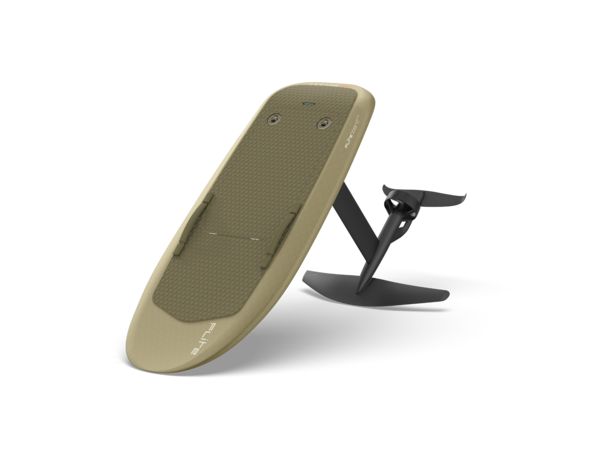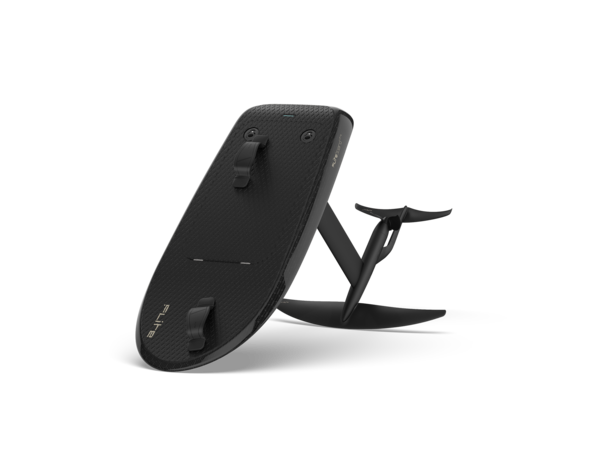Origins of Flite
Flite exists to make the world’s best premium eFoils; whilst catalysing a shift to cleaner and quieter waterways.
Birth of an idea
Fliteboard founder David Trewern grew up surfing and windsurfing from an early age. At a kitefoil event without wind in early 2016, an idea struck to add an electric motor to his foiling kiteboard.
“I became captivated by this vision in my mind of a self-propelled, electric-powered flying surfboard.”
The kitchen became a workshop, and the 3D printer went into overdrive. Dozens of prototypes later, and Fliteboard flew for the first time.
“Within the first few seconds, I knew this was something magical. The feeling of freedom was like nothing else. This would revolutionise water-sports.”
“I’ve been inspired for decades by entrepreneurs such as Steve Jobs, Elon Musk and Henry Ford, and designers like Dieter Rams, Marc Newson and Jony Ive. This was my chance to bring something amazing to the world.”
Awards and accolades
Fliteboard has been highly awarded by the world’s most credible design organisations, such as Red Dot (Germany), German Design Award (Germany), Industrial Designers Society of America – Silver Award (USA), Good Design – Gold Award (Australia).
Fliteboard was also named the Australian Innovation of the Year by Australia By Design, made the Robb Report Best of the Best list for 2020, and was named the world’s best eFoil (2019 and 2020) by Jetsurfing Nation.
Fliteboard also won ‘Most Innovative New Product’ at the Australian Marine Industry Export Awards.

Global Team
While Fliteboard started as a family affair, David went on to assemble a global team of experts, including product and electronics engineers in Melbourne, Hydrodynamicists in California, composites experts in Thailand, gearbox experts in Germany. With passion and teamwork, an award-winning product was born, now enjoyed by thousands of customers in 80 countries around the world.
Today the Flite team consists of over 40 permanent staff across four offices spanning Byron Bay and Melbourne (Australia), Amsterdam (Netherlands), and Nyack, New York (USA).
Fliteboard family have also grown to include a passionate network of Authorised Resellers and Fliteschools.
Fliteboard sustainability.
Ensuring our Blue Planet remains that way.
Able to carry a 90kg human at over 20kph using less than 750 watts of electric power with no emissions or wake, Fliteboard is perhaps the world’s most efficient and environmentally friendly powered marine vehicle.
Fliteboard is quiet above the water and has an underwater acoustic profile significantly less impactful than even the smallest petrol marine motor. Fliteboard ushers in new technologies that, when scaled, have potential to create a future of quiet and clean ocean enjoyment and transport.
Once you have experienced quiet electric hydrofoil flight over water, it becomes immediately clear how out of date the technologies are that we currently use for recreational boating. Waterways should be pristine environments. Flite is developing technology now, for a future without the noise and smells created by burning fossil fuels.
Research
and development
Fliteboard research and development occurs at the intersection of electric vehicle technology, carbon composite and hydrofoil design and technology.
Every Fliteboard comprises hundreds of parts, many of them custom developed.
The Flite team includes Product design engineers, Naval Architects, Mechanical, Electronics and Software engineers.
The majority of our development happens in our factory in Byron Bay, Australia, in close proximity to the Pacific Ocean, where we test our creations almost daily. We also collaborate with experts in specialised fields in the USA, Germany, Thailand and China, in our quest to create the perfect ride.
A board that rides as an extension of your reflexes, that glides harmoniously with nature and is part engineering and part work of art while being a product that is as easy to use as it is fun to own.
The history of eFoils
2008
2009
2016
2017
2018
2020
2021
Pure. Refined.
Inspired by nature.

Fliteboard
— 5’8″ (173cm) 100 litres
— Bestseller
— Versatile
— Early planing
All riders

PRO
— 5’0″ (153cm) 67 litres
— Reduced swing weight
— Enthusiasts choice
— Moderate planing
Confident starters to experts

ULTRA
— 4’2″ (127cm) 54 litres
— World’s smallest
— Optional footstraps
— Late planing
Expert riders

AIR
— 6’0″ (183cm) 150 litres
— Rugged inflatable
— Buoyant & stable
— Beginner friendly
Fliteschools, yachts & resorts
